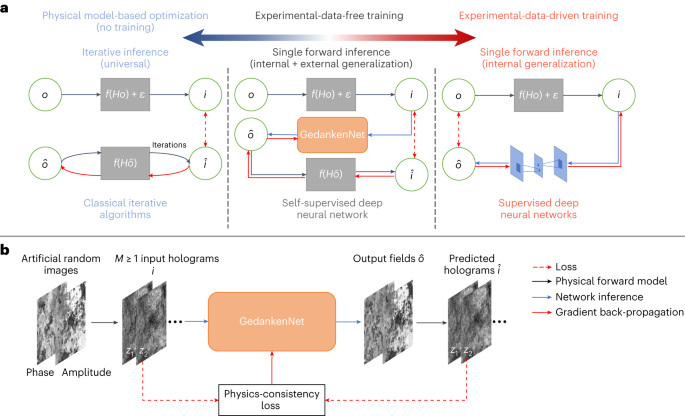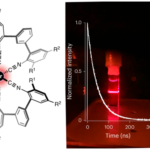2023-08-07 アメリカ合衆国・カリフォルニア大学ロサンゼルス校(UCLA)

- UCLA が、実験対象やリアルデータによる訓練なしでコンピュテーショナル・イメージング(計算撮像)とマイクロスコピー(顕微鏡法)を実行する、人工知能(AI)をベースとしたモデル、「GedankenNet」を開発。
- 物理法則と思考実験から学習するこの自己教師あり(SSL)AI モデルは、相対性理論の創出において可視化された概念的な思考実験を利用するアプローチである、アルベルト・アインシュタインの「Gedankenexperiment(思考実験)」に着想したもの。
- AI は、写真からセンシングまで多様な分野の可視化処理に革新をもたらしているが、顕微鏡法でのアプリケーションは持続的な課題に直面している。既存の AI 搭載モデルは、人間による管理と膨大な量のサンプルを用いた手間とコストのかかる実験を要する大規模かつラベル付けされたデータセットに大きく依存している。また、これらの方法論は、新しいサンプルの型や実験装置の処理に労することが多い。
- 本研究では、空間での電磁波の伝搬を司る物理法則の情報のみをベースに、現実的な実験やサンプル、リアルデータなしの「想像」のみで合成されたランダムな人工のホログラムのみを利用した顕微鏡画像を再構築させるために GedankenNet に学習させた。
- GedankenNet による「思考実験」後、新しい実験装置で捉えた人間の細胞サンプルの 3D ホログラム画像を使ってこの AI モデルの試験を実施。この第 1 段階では、ホログラムから人間の細胞サンプルと子宮頸部表面細胞の顕微鏡画像を再構築することに成功した。
- 大規模な実験データを使用した教師あり学習ベースの最先端の顕微鏡画像再構築手法と比較すると、GedankenNet はサンプルの実験データや事前情報に頼らない、未知のサンプルの汎化能力により優れる。また、波導方程式の物理法則に合致した光波を生成し、空間における 3D 光伝搬を正確に再現した。
- これらの発見は、科学者が行うのと同じように、自己教師あり AI が思考実験から学習できる可能性を示しており、これにより、現在、様々なコンピュテーショナル・イメージングタスクで採用されている標準的な教師ありディープラーニング(DL)手法を代替するものとして、物理法則に親和性のある、訓練が容易で広く汎化が可能なニューラルネットワークモデル開発の新たな機会が開かれる。
- URL: https://samueli.ucla.edu/self-supervised-ai-learns-physics-to-reconstruct-microscopic-images-from-holograms/
<NEDO海外技術情報より>
関連情報
Nature Machine Intelligence 掲載論文(フルテキスト)
Self-supervised learning of hologram reconstruction using physics consistency
URL: https://www.nature.com/articles/s42256-023-00704-7
Abstract
Existing applications of deep learning in computational imaging and microscopy mostly depend on supervised learning, requiring large-scale, diverse and labelled training data. The acquisition and preparation of such training image datasets is often laborious and costly, leading to limited generalization to new sample types. Here we report a self-supervised learning model, termed GedankenNet, that eliminates the need for labelled or experimental training data, and demonstrate its effectiveness and superior generalization on hologram reconstruction tasks. Without prior knowledge about the sample types, the self-supervised learning model was trained using a physics-consistency loss and artificial random images synthetically generated without any experiments or resemblance to real-world samples. After its self-supervised training, GedankenNet successfully generalized to experimental holograms of unseen biological samples, reconstructing the phase and amplitude images of different types of object using experimentally acquired holograms. Without access to experimental data, knowledge of real samples or their spatial features, GedankenNet achieved complex-valued image reconstructions consistent with the wave equation in free space. The GedankenNet framework also shows resilience to random, unknown perturbations in the physical forward model, including changes in the hologram distances, pixel size and illumination wavelength. This self-supervised learning of image reconstruction creates new opportunities for solving inverse problems in holography, microscopy and computational imaging.




